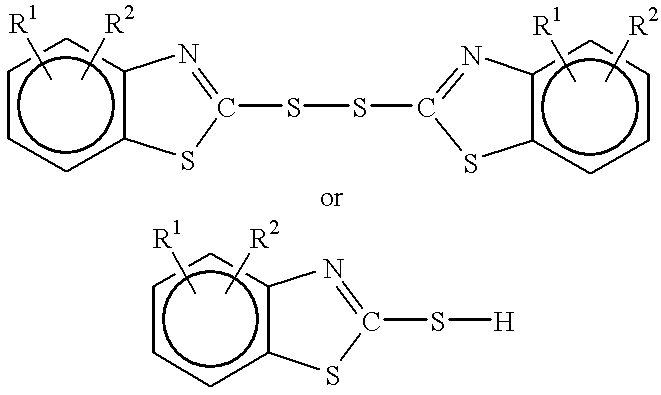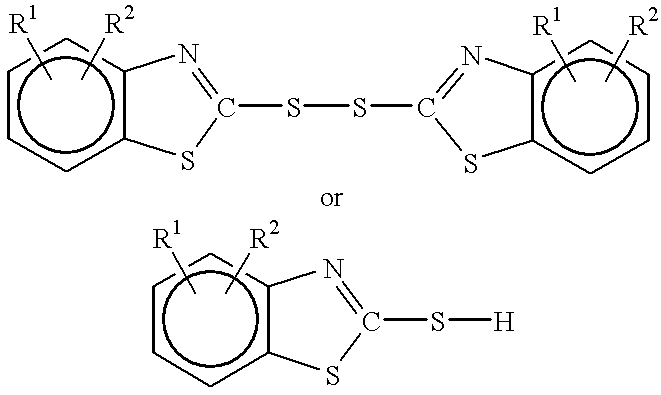Pneumatic tire containing a vulcanization accelerator
a technology of pneumatic tires and accelerators, applied in the field of pneumatic tires, can solve the problems of tire problems, reduce productivity, and extra step
Inactive Publication Date: 2001-12-18
BRIDGESTONE CORP
View PDF5 Cites 13 Cited by
- Summary
- Abstract
- Description
- Claims
- Application Information
AI Technical Summary
Benefits of technology
The present invention has been made under the above circumstances. The first object of the present invention is to provide a pneumatic tire which maintains low rolling resistance at a high level and shows improved ply-end separation in various structures by improving the properties of rubber which are useful for preventing ply-end separation, i.e., resistance to crack growth and high breaking properties, throughout the entire term of tire use.
The second object of the present invention is to provide a pneumatic tire which remarkably improves the resistance to fracture of a bead filler without having adverse effects on workability and thereby can simultaneously improve controllability and durability in the last stage of tire use.
The third object of the present invention is to provide a pneumatic tire having excellent durability by improving a rubber composition used in a belt layer of the tire and thereby preventing aging of the belt layer.
The mechanism of the second aspect of the present invention has not been fully elucidated, but is considered as follows. The additional cross-linking by heat generation during the tire use is decreased because the amount of residual groups of a vulcanization accelerator which cause the additional cross-linking is decreased by using the thiazol vulcanization accelerator represented by the above general formula in the rubber composition, and the decrease in Eb can be prevented without decreasing controllability, which has been improved by the bead fillers of hard rubber, or decreasing the resistance to crack growth. Thus, the durability of the tire in the last stage of tire use is improved.
It is generally known that the adhesion between a steel cord and the belt coating rubber is related to the amount of residual sulfur after vulcanization. The larger the amount of the residual sulfur, the stronger the adhesion in the last stage of tire use. On the other hand, when the amount of residual sulfur is large, a problem arises in that the residual sulfur causes additional crosslinking in the presence of the residue groups of a vulcanization accelerator in the rubber composition, and therefore the resistance to aging under heat becomes inferior.
The mechanism of the third aspect of the present invention has not been fully elucidated, but is considered as follows. The decrease in resistance to aging is prevented without decreasing the amount of residual sulfur which contributes to adhesion because the amount of the residue groups of the vulcanization accelerator which cause additional cross-linking is decreased by using the above specific vulcanization accelerator in the rubber composition, and the improvement in the adhesion and the prevention of aging can be achieved simultaneously.
Problems solved by technology
A tire having this structure, however, with high strain at a ply-end part involves the possibility of ply-end separation causing problems with the tire.
The addition of this extra component causes an extra step and decreases productivity.
This method also adversely affects the workability in calendering in tire production.
Further, the method of improving the resistance to breakage by the EV cure decreases the resistance to crack growth.
In the above specification, nothing is disclosed about ply coating rubber, however, and neither the rolling resistance nor durability of a tire are examined.
Therefore, there is the possibility that the durability of a bead filler may be decreased in the last stage of tire use.
This method therefore does not sufficiently improve the resistance to fracture of a hard bead filler in the last stage of tire use.
Although the breaking properties of a bead filler can be improved by using this method, a problem arises in that the flow property of rubber composition becomes markedly inferior because of the highly reinforcing property of carbon black and workability is deteriorated to a great extent.
As described above, despite the various attempts made, a tire satisfying both controllability and durability, which are important properties required for a pneumatic tire, in the last stage of tire use has not been obtained.
It is known that a decrease in adhesion decreases the durability of the belt layer which, the property of the rubber composition at age, in turn, decreases he durability of the tire.
It is found, however, that this method has a problem that aging property, particularly heat aging property, of the belt coating rubber is deteriorated so that belt-edge separation caused by aging takes place in the last stage of tire use, although adhesion is improved.
No examination has been made, however, on the adhesion of rubber to a metal, such as steel cord.
Method used
the structure of the environmentally friendly knitted fabric provided by the present invention; figure 2 Flow chart of the yarn wrapping machine for environmentally friendly knitted fabrics and storage devices; image 3 Is the parameter map of the yarn covering machine
View moreImage
Smart Image Click on the blue labels to locate them in the text.
Smart ImageViewing Examples
Examples
Experimental program
Comparison scheme
Effect test
examples
The invention will be described in more detail with reference to examples in the sections that follow. The present invention is not to be construed as being limited by the examples, however.
In the examples, part and % means parts by weight and % by weight, respectively, unless otherwise stated.
the structure of the environmentally friendly knitted fabric provided by the present invention; figure 2 Flow chart of the yarn wrapping machine for environmentally friendly knitted fabrics and storage devices; image 3 Is the parameter map of the yarn covering machine
Login to View More PUM
| Property | Measurement | Unit |
|---|---|---|
| height | aaaaa | aaaaa |
| elongation | aaaaa | aaaaa |
| tensile stress | aaaaa | aaaaa |
Login to View More
Abstract
A pneumatic tire formed by using a rubber composition comprising a vulcanization accelerator represented by the following general formula: ##STR1## wherein R.sup.1 represents a hydrogen atom, an alkyl group, or an aryl group, and R.sup.2 represents an alkyl group or an aryl group when R.sup.1 represents a hydrogen atom, and represents a hydrogen atom, an alkyl group, or an aryl group when R.sup.1 represents an alkyl group or an aryl group, in an amount of 0.2 to 8.0 parts by weight per 100 parts by weight of a rubber component. A pneumatic tire which maintains low rolling resistance and is improved to prevent resistance to ply-end separation throughout the entire term of tire use, a pneumatic tire which shows excellent controllability and durability in the last stage of tire use, and a pneumatic tire which prevents heat aging of belt layers and a decrease in the adhesion of steel cord with a rubber composition and shows excellent durability are provided.
Description
BACKGROUND OF THE INVENTION1. Field of the InventionThe present invention relates to a pneumatic tire, and more particularly to a pneumatic tire which can maintain low rolling resistance and is improved to prevent a separation at an end of an carcass ply (ply-end separation) throughout the entire term of tire use, a pneumatic tire which is remarkably improved to prevent the fracture of the hard bead filler in the pneumatic tire caused by tire use and shows improved controllability and durability in the last stage of tire use, and a pneumatic tire which comprises a belt layer having excellent durability.2. Description of Related ArtWith automobile functions and performance becoming continuously enhanced, tires are strongly required to provide a decrease in weight and in rolling resistance (decrease in fuel consumption), and an increase in durability.For decreasing the weight and cost of a tire, and for improving riding quality, a low turnup structure is known in which an end of a car...
Claims
the structure of the environmentally friendly knitted fabric provided by the present invention; figure 2 Flow chart of the yarn wrapping machine for environmentally friendly knitted fabrics and storage devices; image 3 Is the parameter map of the yarn covering machine
Login to View More Application Information
Patent Timeline
 Login to View More
Login to View More Patent Type & Authority Patents(United States)
IPC IPC(8): B60C9/18B60C9/02B60C1/00B60C15/06
CPCB60C1/00B60C9/02B60C15/06B60C9/18Y10T152/10846Y10T152/1081Y02T10/86
Inventor NAKAMURA, SHUNNISHIMAKI, YUICHIYAMANAKA, EIJI
Owner BRIDGESTONE CORP
Features
- R&D
- Intellectual Property
- Life Sciences
- Materials
- Tech Scout
Why Patsnap Eureka
- Unparalleled Data Quality
- Higher Quality Content
- 60% Fewer Hallucinations
Social media
Patsnap Eureka Blog
Learn More Browse by: Latest US Patents, China's latest patents, Technical Efficacy Thesaurus, Application Domain, Technology Topic, Popular Technical Reports.
© 2025 PatSnap. All rights reserved.Legal|Privacy policy|Modern Slavery Act Transparency Statement|Sitemap|About US| Contact US: help@patsnap.com



